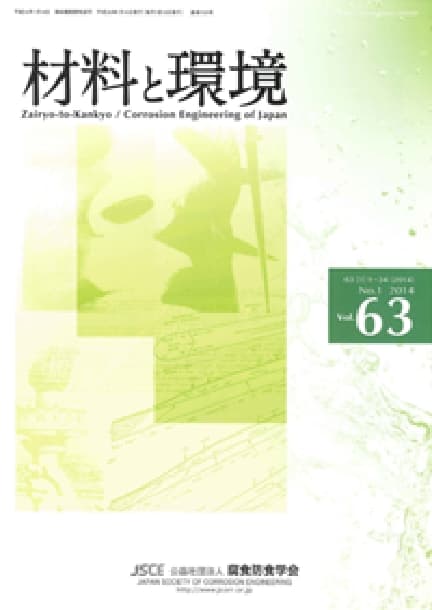- TOP
- Zairyo-to-Kankyo
- Vol. 59 (2010), No. 6
Zairyo-to-Kankyo Vol. 59 (2010), No. 6
Backnumber
-
Vol. 74 (2025)
-
Vol. 73 (2024)
-
Vol. 72 (2023)
-
Vol. 71 (2022)
-
Vol. 70 (2021)
-
Vol. 69 (2020)
-
Vol. 68 (2019)
-
Vol. 67 (2018)
-
Vol. 66 (2017)
-
Vol. 65 (2016)
-
Vol. 64 (2015)
-
Vol. 63 (2014)
-
Vol. 62 (2013)
-
Vol. 61 (2012)
-
Vol. 60 (2011)
-
Vol. 59 (2010)
-
Vol. 58 (2009)
-
Vol. 57 (2008)
-
Vol. 56 (2007)
-
Vol. 55 (2006)
-
Vol. 54 (2005)
-
Vol. 53 (2004)
-
Vol. 52 (2003)
-
Vol. 51 (2002)
-
Vol. 50 (2001)
-
Vol. 49 (2000)
-
Vol. 48 (1999)
-
Vol. 47 (1998)
-
Vol. 46 (1997)
-
Vol. 45 (1996)
-
Vol. 44 (1995)
-
Vol. 43 (1994)
-
Vol. 42 (1993)
-
Vol. 41 (1992)
-
Vol. 40 (1991)
Keyword Ranking
07 Dec. (Last 30 Days)
Zairyo-to-Kankyo Vol. 59 (2010), No. 6
Advances in the Study of Passive Films on Stainless Steels: from Real to Artificial Passive Films and Now from Artificial to Real Passive Films
Nobuyoshi Hara
pp. 212-218
DOI:
10.3323/jcorr.59.212Abstract
Studies of passive films on stainless steels are reviewed from the viewpoint of developing new resources-saved stainless steels (green stainless steels). Starting from the overview of the results of in-situ analyses for the thickness and chemical composition of real passive films, there are describing some important findings obtained from the model experiments using artificial passive films and ion-beam-sputter deposited Fe-Cr thin films, which simulate real passive films and ideal stainless steels, respectively. Finally, recent studies on the pit initiation mechanism at sulfide inclusions and on the improvement of pitting resistance by removal of the inclusions from steel surface are introduced to demonstrate a possibility of developing green stainless steels.
Effect of Ta Addition on Crevice Corrosion Resistance for Ni Based Corrosion Resistant Alloys
Hirokazu Sakai, Katsuo Sugahara, Hitoshi Saito
pp. 222-227
DOI:
10.3323/jcorr.59.222Abstract
The effects of small amount of tantalum addition to a Ni-Cr-Mo alloy on crevice corrosion resistance in 25% NaCl at 107°C was investigated quantitatively by measuring the repassivation potentials for corrosion crevice (ER,CREV). Upon the results, tantalum was revealed to shift the repassivation potentials to the noble direction and the effect was much more than the chromium or molybdenum. For the tantalum free alloys, the crevice corrosion resistance was found to correlate closely with the Pitting Resistance Evaluivalent number (PRE=[%Cr]+3.3([%Mo]+0.5[%W])), however, the tantalum containing alloys were against the correlation. Consequently, PRE(Ta)(=[%Cr]+3.3([%Mo]+0.5[%W])+7.7[%Ta]) was induced by adding a term of [%Ta] to the PRE equation. With this PRE(Ta), the crevice corrosion resistance for the tantalum containing alloys can be estimated.
Improvement of Weathering Resistance for Developed Thermoplastic Polyester Powder Coating for Telecommunication Plant
Yukitoshi Takeshita, Takao Handa, Tamotsu Kudo
pp. 228-231
DOI:
10.3323/jcorr.59.228Abstract
Corrosion is one of the most important problems, particularly in relation to outdoor telecommunication equipment. Some corrosion prevention techniques such as crevice corrosion prevention for stainless steel and protective coatings on galvanized steel have been developed. As regards the latter, we have already developed a duplex protection system that employs resin coating and a galvanizing technique. There has been a need for weathering resistance technology that can protect telecommunications plant materials against damage during long-term use. In this work we have tried to improve the performance under various weathering conditions, in particular under ultraviolet (UV) light, which can easily damage polymer materials. Some powder paints designed to protect against UV light were prepared, and their performances were evaluated both with accelerated UV testing (e.g. with a xenon arc device) and when subjected to natural sunlight outdoor exposure in Okinawa, which has the most severe UV light conditions in Japan. We found that the UV absorber clearly improved the resistance to UV weathering. In addition, we tested for corrosion resistance under severely corrosive conditions outdoors at a coastal location on Miyakejima Island, and found that no blistering, cracking or corrosion occurred at current exposure time.
Article Access Ranking
07 Dec. (Last 30 Days)
-
Perspectives on the Promising Pathways to Zero Carbon Emissions in the Steel Industry toward 2050
ISIJ International Vol.65(2025), No.2
-
Factors Influencing the Bonding Phase Structure of Iron Ore Sinters
ISIJ International Vol.43(2003), No.9
-
Effect of microstructural heterogeneity on fatigue limit of as-quenched low-carbon low-alloy martensitic steel
ISIJ International Advance Publication
-
Delayed Fracture Mechanism of 1700 MPa-Class Quenched and Tempered Bolt under Atmospheric Corrosion Environment
Tetsu-to-Hagané Advance Publication
-
Progress of Strip Casting Technology for Steel; Historical Developments
ISIJ International Vol.52(2012), No.12
-
Research Progress on Optimal Blending of Iron Ore Powders for Sintering
ISIJ International Vol.65(2025), No.12
-
-
Microstructures and Reduction Properties of High CaO Concentration Sintered Ore
ISIJ International Advance Publication
-
Influence of Antimony on the Oxidation Characteristics of 65Mn Steel
ISIJ International Advance Publication
-
Mechanism of Ammonium Thiocyanate Decomposition Driven by Electrolytic Hydrogen Charging
Zairyo-to-Kankyo Vol.74(2025), No.2
You can use this feature after you logged into the site.
Please click the button below.










